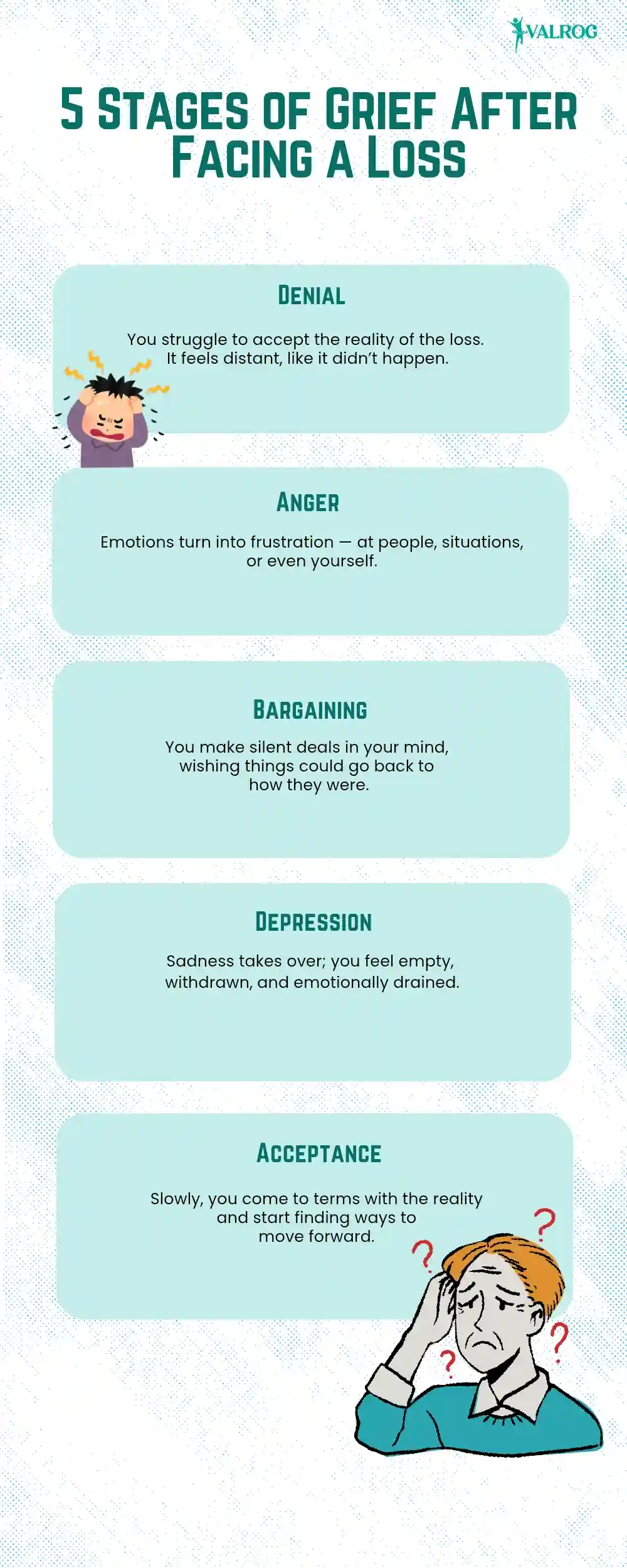Loss hits like a truck. It smashes into your day, your thoughts, your body, unexpectedly or not, it always cuts deep. Whether you’ve lost a loved one, gone through a breakup, or experienced a major life shift, grief doesn’t ask for permission. It just shows up. And while it feels messy and chaotic, there’s a pattern many people go through when faced with deep emotional loss. That pattern is called the stages of grief.
The stages of grief were first introduced by psychiatrist Elisabeth Kübler-Ross in 1969. Originally developed to describe the emotional experience of terminally ill patients, it later became a framework for processing any kind of loss. These aren’t steps you follow one by one like a checklist. They overlap, repeat, twist, turn, or hit you all at once. Still, understanding them helps you recognize what you’re going through and remind yourself, it’s normal.
What Are the Five Stages of Grief in Order?
The stages of grief in order, as Kübler-Ross proposed, are:
- Denial
- Anger
- Bargaining
- Depression
- Acceptance
These stages don’t run like clockwork. You don’t get through one and automatically unlock the next. Think of them more like emotional weather patterns. One minute it’s sunny, the next there’s a storm, and sometimes, both happen in the same hour.
But let’s break them down.

Visit: What are the Symptoms of a Kidney Stone Disorder?
1. Denial – “This can’t be real.”
Denial is the brain’s emergency brake. Everything feels wrong, twisted, surreal. You might feel numb, or like you’re walking through fog. You could be waiting for someone to text you who’s not coming back. Or acting like everything’s fine when it’s clearly not.
Denial isn’t pretending, it’s protection. It helps soften the first wave so your system doesn’t crash.
“Grief is not a disorder, a disease or a sign of weakness. It is an emotional, physical and spiritual necessity…” — Dr. Earl A. Grollman (Grief Counselor and Author)
Some people mistake this as the only stage of grief they’re going through. But more are coming, and often, they hit harder.
2. Anger – “Why is this happening?”
When the fog lifts, pain comes in sharply. Now you’re mad. In the situation. At yourself. At others. Even at the one you lost. It’s confusing, but it’s real. Anger gives grief motion. It has energy.
You might lash out or feel a constant simmering under your skin. Small things can set you off: traffic, noise, silence, memories. It doesn’t always make sense. And that’s okay.
Let’s not forget: the 5 stages of grief in order aren’t clean. You might bounce back to denial or jump ahead. There’s no rulebook.
3. Bargaining – “If only I had…”
Now the “what ifs” take over. You replay moments like a broken tape. Bargaining is a loop of guilt, hope, and desperation.
- “If I had called sooner…”
- “If I didn’t say that…”
- “If I could trade places…”
This stage often comes with insomnia, overthinking, and anxiety. It’s exhausting. You’re trying to regain control over something uncontrollable. You’re looking for reasons, any reasons, to rewrite the ending.
For those facing the 5 stages of grief breakup, bargaining is often the hardest. You might think you can fix it. Or believe they’ll come back. You’re not alone in this. Relationships don’t end cleanly. Feelings linger long after the last word is spoken.

Discover: Aspirin and Tylenol: Can You Safely Take Them Together?
4. Depression – “This hurts.”
This isn’t “just feeling sad.” Depression in grief is heavy. It’s the realization that the loss is real. Permanent. The world feels muted, your energy’s gone, and it might seem like nothing matters.
Now here’s the twist, some frameworks mention 4 stages of grief, stopping here. But stopping here misses something important: growth.
Clinical psychologist George Bonanno highlights that while grief can look like depression, most people recover without long-term mental health issues. Knowing there’s one more stage often gives people hope.
5. Acceptance – “It happened. I’m still here.”
Acceptance doesn’t mean you’re okay with the loss. It means you’ve made room for it in your life. You still miss them. You still remember. But you start to function again.
You can laugh without guilt. Make plans. Find peace in the memories.
And no, it doesn’t always feel like a big moment. Sometimes it’s small:
- You eat your favorite meal again.
- You go a whole day without crying.
- You finally sleep.
This final of the five steps of grief relationship or otherwise is often the slowest. But it’s not the end. It’s where living starts again.
Explore: The Dos and Don’ts of Treating Diarrhea: What to Know About Pepto Bismol Active Ingredient
Therefore,
- Denial
In the early swell of denial, the mind clings, sometimes desperately, to the illusion that reality hasn’t changed, constructing mental scaffolding of alternative outcomes simply to keep the full weight of the loss from collapsing inward all at once.
- Anger
Anger, though often misinterpreted as irrational hostility, frequently masks a subterranean cry for justice in a world that has rearranged itself without warning, offering no apology, no explanation, and certainly no fair exchange.
- Bargaining
During bargaining, our brains become quiet negotiators with the past, erecting imagined timelines where one altered decision might have prevented the pain, no matter how implausible or emotionally unsustainable those mental negotiations become.
- Depression
The depressive stage often feels like an emotional eclipse, where joy is momentarily swallowed by a vast, wordless sorrow, stretching its tendrils into corners of daily life we once filled with certainty, color, and momentum.
- Acceptance
Acceptance isn’t an act of surrender, but rather a recalibration of reality, an emotionally intelligent acknowledgment that although life now beats to a different rhythm, it’s still capable of music.

Wait, What About the 6 or 7 Stages?
You’ve probably heard people talk about the 6 stages of grief, the 7 stages of grieving, or even stages of grief 7 stages. These models expand on the original five to capture the emotional messiness better.
Here’s one version of the seven stages of grieving:
- Shock & Denial
- Pain & Guilt
- Anger & Bargaining
- Depression, Reflection, Loneliness
- The Upward Turn
- Reconstruction & Working Through
- Acceptance & Hope
This version adds nuance. It shows how, after sadness, you might start rebuilding. Slowly, your life doesn’t just “go back”; it shifts. You change. Your relationships change.
And that’s important. Because grief doesn’t end. You just grow around it.
Not Just Death, Grief Has Many Faces
Let’s clear a common myth: you don’t have to lose a person to grieve. People grieve jobs, homes, friendships, health, pets, childhoods, and versions of themselves.
The 5 stages of grief breakup are a very real experience. Breakups can feel like death because something in your life has ended. The routines, the shared future, the inside jokes, they’re all gone. You don’t just miss them. You miss the you that existed with them.
And yes, you might go through the five stages of grief in order, or completely out of order. Again, no rules.
Learn More: Is Stainless Steel Non Toxic? Full Comparison with Cast Iron
So, How Do You Define Grieves?
To define grieves is to name that ache inside when something you loved, needed, or expected is taken away. It’s not weakness. It’s not drama. It’s a deeply human response.
Everyone grieves differently. Some cry. Some go silent. Some clean the whole house or start running marathons. Your way is your way.
But here’s a truth that stands: grief demands to be felt.
How Long Do the Stages of Grief Last?
There’s no timer. Some people move through the stages quickly. Others take years. Some revisit them decades later. Milestones, songs, smells, anything can bring it back.
And that’s okay.
Research from Yale University points out that grief can be active for up to six months or more for most people, but complicated grief, the kind that disrupts daily life for longer periods, may require professional support.
Final Thoughts: Let It Hurt, But Let It Pass Through
There’s no fixing grief. No shortcuts. No hacks. But there’s movement. Slowly, painfully, and beautifully, you move.
You’ll carry the loss. Some days it’ll feel like a feather. Other days, like a mountain. But over time, your muscles get stronger. You start living with it. And sometimes, even because of it.
So yes, the stages of grief matter. They give us language. They help us spot the emotions swirling inside. But more than anything, they remind us, we’re not broken. We’re human.
Check this out: Can I Commit Myself to a Mental Hospital? Signs You Shouldn’t Ignore
Summary: Stages of Grief in Order
- Denial: Shock and numbness.
- Anger: Frustration and pain.
- Bargaining: Guilt and “what ifs.”
- Depression: Sadness and withdrawal.
- Acceptance: Making peace and moving forward.
You could be feeling the 4 stages of grief, struggling through the 5 stages of grief breakup, or resonating with the seven stages of grieving, know this: it’s real, it’s okay, and it won’t always feel this heavy.
